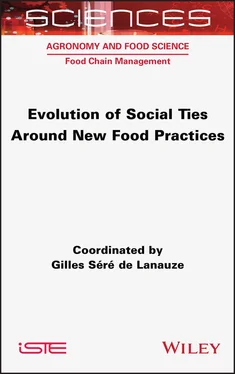Introduction Eating Together, What Are We Talking About? Social Evolution of Today’s Food…
Gilles SÉRÉ DE LANAUZE
MRM Laboratory, University of Montpellier, France
Can we still eat together? The question posed by this book may come as a surprise, especially in France, where the food model is still overwhelmingly based on a traditional organization of three daily meals, as well as on sharing meals with other diners, at 84% for dinner and 75% for lunch. However, while Rozin (1994) has shown that in the imagination of individuals, eating means sharing with others, around a table; this seems more difficult today, and we observe that for the last 20 years, the number of people eating alone is increasing, as well as the number of people eating outside the home 1 . Sharing the same meal around a table is becoming complex because of distance and the different agendas, concerns and paces of life of people who are close. Societal developments such as the rise of individualism, the break-up of families, or nomadism generated by the constraints of active life, weaken the traditional links that used to be formed around meals. Several ways of not “eating together” are thus revealed: eating alone of course, as well as not eating the same thing, not eating in the same place, eating within a different and chosen community. Thus, beyond the fact that we increasingly eat alone, many other fault lines seem to appear in the practices and social perimeters of food consumption. At the same time, other links are being re-formed within new communities of practice or belief, and the implementation of the shared meal depends on new forms of daily organization. And if we do not eat together as much as we used to, we may eat more connected to others, and with more conviction.
Sharing the same meal around a table also becomes complicated when food choices tend to be individualized. Exclusionary diets (gluten-free, lactose-free, meat-free, etc.) are multiplying. The development of intolerances and allergies to certain food products leads to a departure from the traditional patterns of gastronomy and conviviality. At the same time, growing concerns for health and the environment are generating new practices, new product offerings and new forms of market segmentation. Some practices are even more committed, such as veganism which, beyond the refusal of any consumption involving animal exploitation, often takes a stance of both societal disruption and proselytism. Thus, multiple factors are likely to generate differences, antagonisms or frictions in the relations and practices related to food. The development of particular diets, motivated by health, environmental or ethical concerns or imperatives, seems to generate new barriers to eating together.
Religious prohibitions are also at the origin of withdrawal into particular ethnic or community regimes. We also note that the religious issue has led to the appearance of a wide range of new products on the market (numerous halal and kosher product lines), which find their clientele in the corresponding community, as well as among other consumer segments in accordance with trends observed towards ethnic or cross-cultural products.
These changes in terms of relationships with others, conviviality and sharing go beyond the simple perimeter of the meals themselves and also characterize the practices associated both upstream and downstream from the meal. Upstream, we can mention shared supplies, either between consumers (grouped purchases) or between consumers and producers (AMAP 2 , organic baskets), or the development of “cooking together” practices (courses, tastings, tutorials, reality shows, chefs’ blogs). Downstream, we can observe the growing inclusion of gastronomy and commensality within other forms of sharing: meals are then offered not in classic and commercial places like restaurants, but in new alternative, tourist, campaigner or artistic contexts that rely on food to enrich other types of experiences. Commensality is then a pretext for sharing new experiences, emotions or convictions that go beyond their sole nutritional and hedonic objectives.
Sharing values rather than a meal: in an often anxiety-provoking context, consumers are looking for answers to the many economic, social, health and environmental issues linked to our consumption patterns; as a consequence, they are questioning the models of food consumption in order to take greater responsibility. Food takes on the dimension of supporting values. Societal or environmental convictions lead to the critique of certain categories of products deemed harmful because of their ecological footprint or their consequences on public health (meat, processed products, etc.). This favors particular modes of consumption, increased social pressure on what is good or bad to consume and retreating into communities of practice around new principles (organic consumption, local consumption, direct distribution, responsible consumption, etc.). Are these communities the new form of socialization around food that, in many cases, would replace the traditional family and social sharing?
While food is a means of supporting individual and social identities, it is at the heart of the relationships that we share with others. Food practices and convictions result in a chosen membership of groups, to which we identify or refer to, or on the contrary, from which we distinguish ourselves. These groups are an important element of the individual’s social environment, whether physical or virtual, made up of relatives or strangers. They influence behavior and consumption practices and structure our identity. They play a role in the construction of the self, through adherence to and identification with models, or even communities of adoption, while at the same time, relationships outside of groups allow us to assert our own difference within society. Such communities are developing; they are sharing communities (Internet communities, religious or local communities) that are structured fully or incidentally around food. What are the mechanisms of adhesion to these communities, what returns do individuals expect from them and how does the community itself influence food behaviors? This question of social influences and intra- and extra-group relations on food is at the heart of this book.
Finally, these consumer trends are obviously reflected at the level of supply. Product innovation, distribution structures and the very organization of markets and chains of actors are accompanying these changes and new ways of eating. This is the case, for example, of the halal meat production chain, which has benefited from a complete reorganization of the production, control and distribution chains, with the emergence of new players and the development of an offer that takes into account both market expansion and identity support. Another illustration is the market for vegetarian products and services (catering, advice and support, literature), which is committed to the management of facilitated relations between followers and non-adherents. And we find new ways of consuming, as well as of producing and living together at the local level around food, with the re-enchantment of the terroir 3 as a place of sharing and conviction.
Between social influences, norms, communities and questions of identity, the objective of this book is to bring a reflection on the current evolution of social phenomena around food and their influences on the evolution of these markets . This reflection is articulated through six chapters briefly summarized as follows.
The recognition of the benefits of “eating together” is such that it has led to official recommendations from public authorities. This is the subject of Chapter 1, “Eating Together”, a PNNS Recommendation. How Can it be Put Into Practice? In order to promote a balanced diet on a daily basis, the French National Nutrition and Health Plan ( Plan National Nutrition Santé , PNNS) is based on the social aspects of eating: eating together on a daily basis would be a guarantee of a more nutritional diet, because we would take more time to eat, we would cook more recommended products such as fruits and vegetables, and this would limit snacking. However, as with other recommendations made by public authorities (five fruits and vegetables a day), if consumers seem to know the recommendation to “eat in company”, its application is not satisfactory. It is therefore with the aim of overcoming this lack of application that this chapter focuses on the implementation of the “eat with company” recommendation. Data were collected using a qualitative study of food practices combining a projective collage method with individual interviews and observations. The results show that eating in company implies taking on a social role during meals and that culinary knowledge is used to satisfy the guests. The results also show that it is necessary to articulate our activities and those of others in time and space in order to meet around a meal.
Читать дальше












